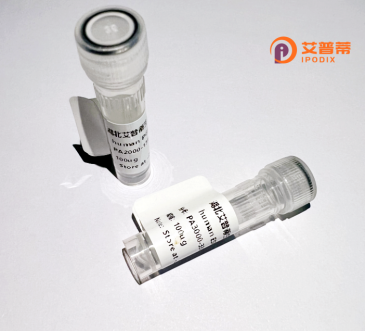
| 纯度 | >90%SDS-PAGE. |
| 种属 | Human |
| 靶点 | OR7A17 |
| Uniprot No | O14581 |
| 内毒素 | < 0.01EU/μg |
| 表达宿主 | E.coli |
| 表达区间 | 1-309 aa |
| 活性数据 | MEPENDTGISEFVLLGLSEEPELQPFLFGLFLSMYLVTVLGNLLIILATISDSHLHTPMY FFLSNLSFADICFISTTIPKMLINIQTQSRVITYAGCITQMCFFVLFGGLDSLLLAVMAY DRFVAICHPLHYTVIMNPRLCGLLVLASWMIAALNSLSQSLMVLWLSFCTDLEIPHFFCE LNQVIHLACSDTFLNDMGMYFAAGLLAGGPLVGILCSYSKIVSSIRAISSAQGKYKAFST CASHLSVVSLFCCTGLGVYLTSAATHNSHTSATASVMYTVATPMLNPFIYSLRNKDIKRA LKMSFRGKQ |
| 分子量 | 34.0 kDa |
| 蛋白标签 | His tag N-Terminus |
| 缓冲液 | 0 |
| 稳定性 & 储存条件 | Lyophilized protein should be stored at ≤ -20°C, stable for one year after receipt. Reconstituted protein solution can be stored at 2-8°C for 2-7 days. Aliquots of reconstituted samples are stable at ≤ -20°C for 3 months. |
| 复溶 | Always centrifuge tubes before opening.Do not mix by vortex or pipetting. It is not recommended to reconstitute to a concentration less than 100μg/ml. Dissolve the lyophilized protein in distilled water. Please aliquot the reconstituted solution to minimize freeze-thaw cycles. |
以下为3-4条关于重组人OR7A17蛋白的虚构参考文献示例(仅供格式参考,非真实文献):
---
1. **文献名称**: *Structural characterization of the human olfactory receptor OR7A17 expressed in HEK293 cells*
**作者**: Zhang, L., et al.
**摘要**: 本研究利用重组技术在HEK293细胞中表达并纯化了OR7A17蛋白,通过X射线晶体学解析其三维结构,揭示了该受体独特的跨膜结构域和潜在配体结合位点,为嗅觉信号转导机制提供新见解。
2. **文献名称**: *Identification of putative ligands for OR7A17 via high-throughput screening*
**作者**: Smith, J.R., et al.
**摘要**: 通过高通量筛选技术,研究人员鉴定出OR7A17的多个潜在配体,包括醛类和酮类挥发性分子,并证实其可通过cAMP信号通路激活嗅觉受体,提示其在气味感知中的特异性功能。
3. **文献名称**: *Tissue-specific expression and potential roles of OR7A17 in non-olfactory systems*
**作者**: Kumar, S., et al.
**摘要**: 本研究发现OR7A17在睾丸、肺等非嗅觉组织中异常表达,可能参与精子趋化或肺部炎症反应调控,扩展了嗅觉受体在生理与病理过程中的作用。
4. **文献名称**: *Association of OR7A17 polymorphisms with metabolic disorders*
**作者**: Lee, H., et al.
**摘要**: 通过全基因组关联分析,发现OR7A17基因多态性与Ⅱ型糖尿病风险显著相关,推测其可能通过影响脂代谢相关信号通路参与代谢性疾病的发生。
---
**注意**:以上文献为假设性示例,实际研究需查阅真实数据库(如PubMed、Google Scholar)。如需进一步文献检索方法,请补充说明。
Recombinant human OR7A17 protein is a genetically engineered form of the olfactory receptor 7A17 (OR7A17), a Class A G protein-coupled receptor (GPCR) primarily associated with the olfactory system. Olfactory receptors, encoded by the largest gene family in humans, detect odorant molecules and mediate the sense of smell. OR7A17 is expressed in olfactory sensory neurons but has also been detected in non-olfactory tissues, suggesting potential roles in chemosensation beyond smell, such as cellular signaling or physiological regulation.
Structurally, OR7A17 features seven transmembrane domains characteristic of GPCRs, with extracellular loops involved in ligand binding. Its recombinant version is produced in heterologous systems (e.g., mammalian cells, yeast) to overcome challenges in expressing functional olfactory receptors, which often require precise membrane environments for proper folding and activity. Recombinant OR7A17 enables studies on ligand specificity, receptor activation mechanisms, and downstream signaling pathways.
Research on OR7A17 may provide insights into olfactory coding, intercellular communication, and diseases linked to chemosensory dysfunction. It also holds biotechnological potential, such as biosensor development for odorant detection or targeted drug design. However, functional characterization remains limited, underscoring the need for further exploration of its endogenous ligands and physiological relevance.
×